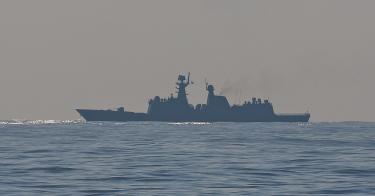Since the end of the Cold War, America has enjoyed an uncontested position at the top of the global hierarchy. However, the rise of China as a peer adversary backed by an unprecedented naval buildup is rapidly changing the post-Cold War correlation of power. And as America struggles with shipbuilding delays and an overstretched Navy, it risks being unprepared for the challenges ahead.
China today possesses the world’s largest naval fleet, boasting an active inventory of 405 fleet units, and is continuing to expand, with projections placing it at 435 units by 2030.
It would be unwise to write off the threat of China’s navy just because its fleet is not as technologically advanced as that of the U.S. Navy. After all, victory at sea is a team effort, and rarely does a single warship decide the outcome of war.
There are many examples of the battlefield advantages of a large number of relatively less advanced technologies. In World War II, the German Tiger was the most advanced tank on the battlefield, but its mechanical complexity and high price tag meant Germany built only a relatively small number of them. Ultimately, they were overwhelmed by the less complex and more vulnerable, but quantitatively superior, U.S. Shermans.
>>> China’s Defense Budget Is Bigger Than You Think
Further, should the current conflicts in Europe and the Middle East expand and bring the United States in as direct combatants, the U.S. military would be hard pressed to fight both conflicts simultaneously while still deterring Chinese aggression. Should an additional war break out in the Pacific, the U.S. military might be so thinly stretched trying to address all contingencies simultaneously that it fails in one or even all three conflicts. Even if it succeeds in all three theaters, the U.S. military may be so depleted that it would take substantial time and resources to return to an acceptable readiness level, putting the nation in a prolonged period of vulnerability.
This parallels history, as the British Empire faced a similar predicament before WWII. When Germany sought to build up its navy in the 1930s, Great Britain should have recognized the threat and increased the size of its own navy to confront an emerging Axis of Germany, Japan and Italy. It instead pursued appeasement and was ill-equipped to fight a world war, resulting in a stinging naval defeat with the sinking of key ships by Axis powers early in the war that essentially left Britain’s holdings in East Asia undefended.
In the end, Britain won the war, but it lost its empire after exhausting its military trying to fight against German, Italian, and Japanese forces across the globe.
The United States today may be similar to that of the British Empire of 1938. Indeed, in the event of war with China, Iran could decide to escalate in the Mediterranean and the Strait of Hormuz, meaning that the U.S. military may have to choose between trying to fight two adversaries in two different theaters simultaneously and risking battlefield defeat or prioritizing one theater while accepting risk in the other.
Today, America’s Navy is plagued by cost and schedule overruns as it tries to replace and modernize its fleet from the 1980s and 1990s.
Analysis strongly suggests that America needs a larger Navy. Congress has mandated a fleet of 355 ships, but The Heritage Foundation analysis has consistently stated that a manned fleet of no fewer than 400 warships is required.
In 2023, the Navy itself said it needs a force of 381 battle force ships and 134 unmanned surface and undersea vessels, for a total of 515 naval platforms. Further, America’s under-resourced and under-manned Navy has experienced a much higher than average operational tempo for years, increasing wear and tear on ships and reducing training times.
>>> The West Is Terrifyingly Vulnerable to Chinese Hacking of GPS
In short, America’s current Navy is underequipped to maintain a global presence in peacetime, let alone in the event of war with China or, worse, multiple powers at once.
At the same time, a 2019 Reuters article reported that China has produced more vessels since 2014 than the U.K. had in its entire fleet. And the momentum has not slowed. As China powers full steam ahead, the United States has cut procurement of Virginia-class submarines and the Navy is seeing delays on Virginia and Columbia class submarines, Constellation class frigates, and the next Ford-class aircraft carrier.
The United States can no longer afford to overlook the mounting threat posed by China’s rapidly expanding navy. Overtaxed with too many global commitments, the U.S. Navy is struggling to maintain its global presence, let alone prepare for a possible conflict against China—much less against a coalition of adversaries. Historical precedents, from Britain’s naval failures before World War II to modern conflicts demonstrating the power of numerical superiority, serve as stark warnings.
If the U.S. fails to address these challenges, it risks finding itself much like the United Kingdom in 1947: ultimately, having won the war, but at the cost of its place in the world.
This piece originally appeared in The Washington Times





